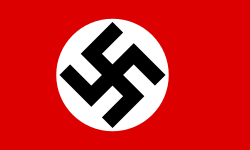

German-occupied Europe | |||||||
|---|---|---|---|---|---|---|---|
| 1938–45 | |||||||
| Anthem: 1938–45 "Das Lied der Deutschen" "The song of the Germans" | |||||||
Map of Europe from 23 August to 10 September 1942, highlighting the German Reich and its occupied territories. (client states not included): | |||||||
| Capital | Berlin | ||||||
| Common languages | German | ||||||
| Demonym | German | ||||||
| Reichskommissar | |||||||
• 1938–45 | Fritz Katzmann | ||||||
| Reichsstatthalter | |||||||
• 1938–45 | Adolf Eichmann | ||||||
• 1940–46 | Heinrich Himmler | ||||||
• 1941–45 | Hermann Göring | ||||||
| Historical era | Interwar period World War II | ||||||
| Area | |||||||
| 1941 | 3,300,000 [1] km2 (1,300,000 sq mi) | ||||||
| Population | |||||||
• 1941 | 238,000,000 [1] | ||||||
| Currency | Reichsmark (ℛℳ) | ||||||
| |||||||
German-occupied Europe, or Nazi-occupied Europe, refers to the sovereign countries of Europe which were wholly or partly militarily occupied and civil-occupied, including puppet states, by the Wehrmacht (armed forces) and the government of Nazi Germany at various times between 1939 and 1945, during World War II, administered by the Nazi regime, under the dictatorship of Adolf Hitler. [2]
Contents
- History
- Concentration camps
- Occupied countries
- Governments in exile
- See also
- Notes
- References
- Bibliography
- Primary sources
- External links
The Wehrmacht occupied European territory:
- as far north and east as Franz Joseph Land in Arkhangelsk Oblast, Russian SFSR, Soviet Union (1943–1944)
- as far south as the island of Gavdos in the Kingdom of Greece
- as far west as the island of Ushant in the French Republic
In 1941, around 280 million people in Europe, more than half the population, were governed by Germany or their allies and puppet states.[ citation needed ]
Outside of Europe, German forces controlled areas of North Africa, including Egypt, Libya and Tunisia between 1940 and 1945. German military scientists established the Schatzgraber Weather Station as far north as Alexandra Land in Francis Joseph Land. Manned German weather stations also operated in North America included three in Greenland: Holzauge, Bassgeiger , and Edelweiss.[ citation needed ] German Kriegsmarine ships also operated in all oceans of the world throughout World War II but maintained their focus in the North Sea and the North Atlantic. There were certain cases of U-boats being present in other more difficult to reach oceans as well, such as furthest in the west being in the Gulf of Mexico. A few cases of cooperation with the Imperial Japanese Navy led to U-boats being in the Pacific Ocean. There were also cases in the Indian Ocean with German U-boats using the Japanese occupied port of Palang[ citation needed ] in order to disrupt allied convoys further and in the Arctic Ocean German U-boats intercepted Allied convoys heading to Murmansk while also possibly damaging crucial Lend lease at the same time.[ clarification needed ]




